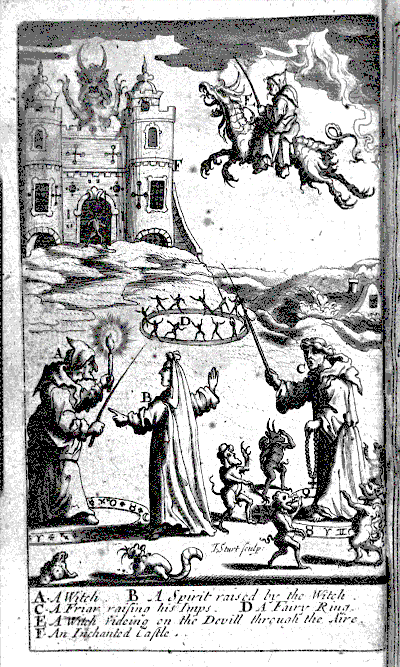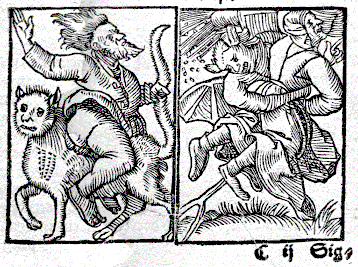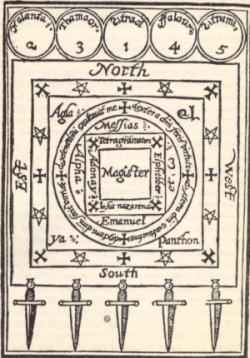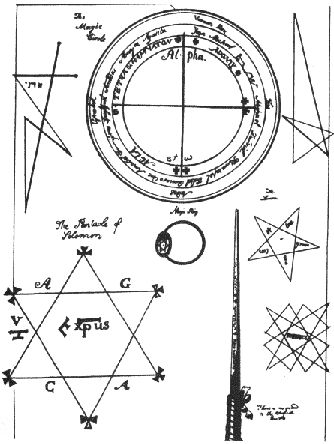|
Deviltry The timeless parable of Faust inevitably provokes the same moral awakening in virtually everyone, the haunting siren call of ethics, the powerful insight: "I could have cut a better deal than THAT."
The timeless parable of Faust inevitably provokes the same moral awakening in virtually everyone, the haunting siren call of ethics, the powerful insight: "I could have cut a better deal than THAT."The art of deviltry, or demonology, is all about cutting the perfect deal. It really doesn't matter how many times you see it turn out badly in movies, plays and classical literature. It would turn out differently for you, because you're special. For those who think it's a sin to cut bargains with supernatural entities, well, try spending 30 seconds in unexpected freefall on an airplane encountering turbulence and see how many promises you make God before the half-minute is up. So it's not really a question of the transaction so much as who you choose to deal with. Prior to the full development of Christianity, there was little call for demonic dealing, since no one really believed in demons. Religions as far back as the Babylonians included rituals for summoning and controlling demons, but that was in the context of polytheism, which is an entirely different view of the universe. Back then, you believed in many gods, good and bad, all of whom had special rituals and sacrifices which pleased them and in exchange for which they would provide specialized services. As monotheism ran rampant over the globe, starting around the 4th century A.D., the concept of having neighborhood gods in charge of potholes and cornfields was frowned upon frowned upon in a burn-you-at-the-stake, take-your-homes, rape-your-wife and sell-your-children-into-slavery kind of way. However, the severe penalties for trafficking with supernatural beings didn't sway most people. Instead of openly appeasing the local gods, they began surreptitiously appeasing the local gods. The real concept of trafficking with devils was, ironically enough, an invention of the Catholic church. Around the Middle Ages, when the Roman church first really asserted itself as a political power, the papacy began a systematic campaign to assimilate or erase the indigenous religions in its spheres of influence. This took two forms: Local deities and legends were often co-opted into Christian saints, such as St. Patrick in Ireland, and all remaining vestiges of the indigenous religion were branded as the work of Satan. If a local deity wasn't re-invented as a saint, he or she became ipso facto a manifestation of Hell, whether Satan himself or a demon in his thrall. Witchcraft in every form was also condemned, since the church wanted to reserve all measurable forms of power to itself. Catholic doctrine states that any form of witchcraft or magic can be accomplished solely by means of a "diabolical pact" with Satan or his minions. (This flies in the face of the fact and history of most magical practices, but we're not talking about a well-reasoned position here.)
In fact, not ONLY did it work, but the church was so terrified of demonology that it dispatched the Inquisition to ruthlessly murder every single person who showed even the slightest interest or involvement in the practice. The church offered the alternative of performing novenas or praying to patron saints in charge of various tasks like obtaining new shoes or removing warts, but angels and saints are notoriously unreliable when it comes to providing favors. Furthermore, when you seek assistance from, let's say, St. Francis of Assisi, the outcome is likely to involve poverty, chastity or humility. Devils, on the other hand, were associated with carnal pleasures, greed, wealth and power in other words, things people actually want. The Inquisition itself spurred interest in demonology and the occult right up through the Renaissance, with its lists of lurid charges against its alleged practitioners. These charges included claims of fabulous powers and uninhibited orgies, which are not exactly repugnant to a significant segment of the population. The Inquisition also targeted wealthy groups like the Knights Templar, who had it pretty good before getting killed off. If the rich and powerful Templars were taking part in the Black Arts, the risk-reward calculation wasn't completely prohibitive.
The medievalists defined the shape of occultism for centuries to come, spending reams of paper on scary-looking spellbooks known as grimoires. They practiced a combination of ceremonial and traditional Magic, with healthy doses of the Kabbalah thrown in for good measure. The demons of hell were classified according to their powers and specialties, and each was given a name. The basic concept of demonology, found in various magical traditions, is that knowing the name of an entity gives the sorcerer power over that which is named. If you're interested in trying this, some demon names (often also angelic names) include Aztahoth, Azrael, Gedulahel, Geburahel, Tiphereth, Binahel, Ruach Chokmahel, Ketheriel, Shaddal and Tzabaoth. Even God's power could (in theory) be accessed by those who knew his four-letter name, referred to as the Tetragrammaton (which means, cleverly enough, "four-letter name"). The Bible/Torah specifies that this name is JVJH, pronounced Jehovah or Yahweh. Even though it was forbidden to speak this name in Jewish and Christian doctrine, they got to be pretty well known by the Middle Ages, so the medievalists invented... I mean, "discovered" the real secret name of God, which varied according to your preference. AGLA was one popular version. Once known, the names of demons could be used to summon and command them. The standard practice of invocation is to cast a circle of protection. The sorcerer either stands safely inside the circle awaiting the demon's arrival, or traps the arriving demon within the circle. It helps to have fire on hand, and magical tools such as wands and cups. A good supply of blood can't hurt either.
Rotten.com is not responsible for the outcome of any ill-advised experimentation in demon summoning. But if it works, send us a picture. We'd really like to see it. When the demon presumably makes its appearance, the sorcerer can command it, using its name, to do whatever task the sorcerer doesn't want to do himself. Aside from the fact that you may be exposing yourself to the risk of eternal damnation, demons are notorious for being really pissed off when mere mortals command their obedience, so you had better be very careful about how you phrase your request. Demons will interpret your words very literally. For instance, "make this headache go away" is likely to result in decapitation rather than the delivery of a bottle of infernal aspirin. For whatever reason, the medieval vision of demonology really had some staying power. Variations on the formula were promulgated by secret societies such as the Golden Dawn and the Ordo Templi Orientis right up through the 20th century. Many of the rituals designed by Aleister Crowley are based on the medieval model, although his influences were pretty wide-ranging. On the bright side, it's pretty unlikely that you'll be burned at the stake for dabbling in this stuff within the continental United States, Canada, and most of the European Union (we can't make guarantees elsewhere). On the down side, it's hard to cite a list of successful uses of demonic pacts, since a) they haven't been proven to be real and b) if they are real, there are good reasons not to talk about them. However, we can speculate. If demonic pacts are the real deal, there are some people whose lives and careers beg for further investigation, including Courtney Love, Bill O'Reilly, Gallagher, Jerry Falwell, Hugh Hefner, Bill Clinton and George W Bush.
|
 The association of the devil with popular native traditions may not have been the wisest idea, but the next idea was even worse. Having made this formal pronouncement, the church proceeded to declare war on witchcraft. Starting in the seventh century, the church made very clear not only that it took witchcraft (now defined as pacts with the devil) very seriously, but it also firmly believed that such pacts were in fact EFFECTIVE. In other words, IT WORKED!
The association of the devil with popular native traditions may not have been the wisest idea, but the next idea was even worse. Having made this formal pronouncement, the church proceeded to declare war on witchcraft. Starting in the seventh century, the church made very clear not only that it took witchcraft (now defined as pacts with the devil) very seriously, but it also firmly believed that such pacts were in fact EFFECTIVE. In other words, IT WORKED!  Somehow all these weird conflicting tales, many of which appear to have originated with the witch-hunters, eventually became actual practices, advanced by various practioners of such banned activities as alchemy and science. Medieval occultists developed incredibly intricate cosmologies and rituals designed to provide access to a host of demon servants for all manner of ill-doing.
Somehow all these weird conflicting tales, many of which appear to have originated with the witch-hunters, eventually became actual practices, advanced by various practioners of such banned activities as alchemy and science. Medieval occultists developed incredibly intricate cosmologies and rituals designed to provide access to a host of demon servants for all manner of ill-doing.  The circle can be a plain circle, or a circle surrounding a pentagram, hexagram or other design. It can be drawn with chalk or preferably by pouring salt. If you're going to try this, it's highly advised that the circle be completely perfect and unbroken. You may wish to have other secret signs and magic words inscribed around the circle. It's not a bad idea to be wearing some sort of
The circle can be a plain circle, or a circle surrounding a pentagram, hexagram or other design. It can be drawn with chalk or preferably by pouring salt. If you're going to try this, it's highly advised that the circle be completely perfect and unbroken. You may wish to have other secret signs and magic words inscribed around the circle. It's not a bad idea to be wearing some sort of